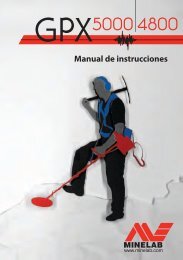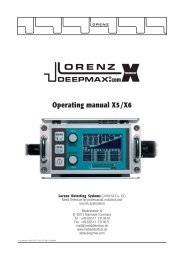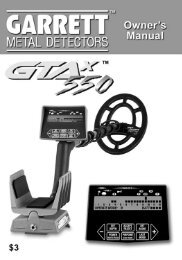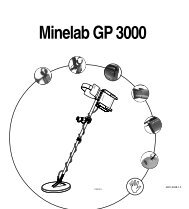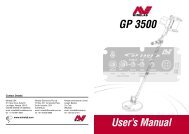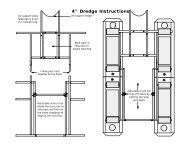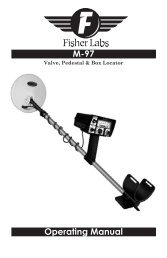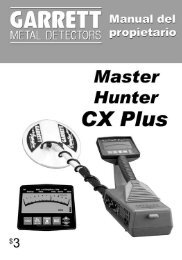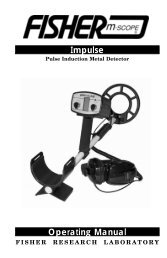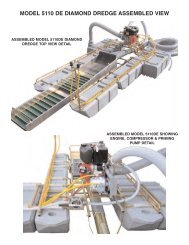Instruction Manual - Kellyco Metal Detectors
Instruction Manual - Kellyco Metal Detectors
Instruction Manual - Kellyco Metal Detectors
You also want an ePaper? Increase the reach of your titles
YUMPU automatically turns print PDFs into web optimized ePapers that Google loves.
<strong>Instruction</strong> <strong>Manual</strong>
World Leader in <strong>Metal</strong> Sensing Technology<br />
Minelab Electronics Pty Ltd<br />
1<br />
From our origins in 1985, Minelab have specialised in advanced<br />
electronic technologies. Our competitive advantage was created<br />
almost immediately with a highly competent and innovative Research<br />
and Development team, inspired by the genius of Mr Bruce Candy.<br />
This commitment to innovation has enabled us to successfully market<br />
feature-packed Consumer coin and treasure detectors enjoyed by<br />
hobbyists worldwide as well as high quality gold detectors used by<br />
both professionals and amateurs. Minelab’s advanced technology is<br />
also incorporated into detection equipment designed for military and<br />
humanitarian de-mining projects throughout the world.<br />
Today Minelab has manufacturing, distribution and customer service<br />
operations in Australia, Europe and the United States, and is an ISO<br />
9001 Quality Endorsed Company. ISO 9001 is a worldwide quality<br />
standard certification that ensures the highest level of product quality<br />
for our customers.<br />
For further product information<br />
and detecting tips, refer to:<br />
PO Box 537, Torrensville Plaza<br />
Adelaide, South Australia, 5031<br />
Australia<br />
Tel: +61 (0) 8 8238 0888<br />
Fax: +61 (0) 8 8238 0890<br />
Email: minelab@minelab.com.au<br />
Minelab International Ltd<br />
Laragh, Bandon<br />
Co. Cork<br />
Ireland<br />
Tel: +353 (0)23 885 2101<br />
Fax: +353 (0)23 885 2106<br />
Email: minelab@minelab.ie<br />
Minelab USA Inc<br />
871 Grier Drive, Suite B1<br />
Las Vegas, Nevada, 89119<br />
USA<br />
Tel: +1 702 891 8809<br />
Fax: +1 702 891 8810<br />
Email: info@minelabusa.com<br />
Congratulations on<br />
purchasing your x-terra!<br />
<strong>Metal</strong> detecting is a fascinating and rewarding<br />
activity enjoyed by people all over the world.<br />
By getting to know your X-Terra you can<br />
become one of the many who find valuable<br />
coins, relics and jewellery on a regular basis.<br />
The X-Terra is a high-precision instrument<br />
incorporating Minelab’s proven single<br />
frequency technology, VFLEX.<br />
VFLEX processes a pure single frequency,<br />
ensuring that you can enjoy the hobby at all<br />
times, confident that you are using a highlytuned<br />
and dependable detector. In other<br />
words, a SERIOUS detector.<br />
This pocket sized manual is designed to help<br />
both the beginner and expert treasure hunter<br />
get the best performance out of the X-Terra<br />
305 and X-Terra 505.<br />
This asterisk will appear<br />
throughout the manual,<br />
indicating features only<br />
available on the X-Terra<br />
505 model.<br />
www.Minelab.com
2 contents 3<br />
4 VFLEX Technology<br />
6 Assembling Your X-Terra<br />
8 Connecting the Coil<br />
9 Shaft Assembly<br />
10 Armrest Assembly<br />
11 Connecting the Control Box<br />
12 Permanently Connecting the<br />
Control Box<br />
13 Coil Cable Assembly<br />
14 Inserting Batteries<br />
Quick Start Reference Back Cover<br />
Part Number: 4901-0071-1.0<br />
Detecting Basics<br />
15 Holding the Detector<br />
17 Sweeping the Coil<br />
18 Introducing the Control Panel<br />
19 Keypad Layout<br />
20 Turning on the Detector<br />
21 LCD Layout<br />
22 Detecting Exercise<br />
24 Example Detections<br />
26 How <strong>Detectors</strong> Work<br />
27 Target ID<br />
28 Discrimination Scale<br />
30 Preset Discrimination Patterns<br />
34 Choosing a Discrimination Pattern<br />
36 Pinpointing<br />
38 Recovering the Target<br />
Detailed Detector Operation<br />
40 LCD Icons<br />
44 Operation<br />
45 Selecting Menu Settings<br />
46 Sensitivity<br />
47 Adjusting Sensitivity<br />
48 Noise Cancel<br />
49 Choosing a Noise Cancel Channel<br />
50 Threshold<br />
51 Adjusting Threshold<br />
52 Volume<br />
53 Adjusting Volume<br />
54 Tones<br />
55 Adjusting Tones<br />
56 Ground Balance<br />
58 Adjusting Ground Balance<br />
60 Editing Discrimination Patterns<br />
60 Method 1<br />
61 Method 2<br />
62 Erasing Patterns<br />
63 Factory Presets<br />
Reference Information<br />
64 Sounds<br />
66 Error Messages<br />
67 Coil Identification<br />
68 Battery Behaviour<br />
70 Care of your X-Terra<br />
72 Accessories<br />
74 X-Terra Specifications<br />
75 X-Terra Model Features<br />
76 Service and Repair Form
Power<br />
Supply<br />
Audio<br />
Transmit<br />
Analog Signal<br />
Transmit<br />
Standard VLF Signal<br />
(Without VFLEX)<br />
Precision VFLEX Signal<br />
The 2nd generation X-Terra Series incorporate<br />
Minelab’s proven VFLEX Technology.<br />
VFLEX uses state of the art digital and mixed-signal<br />
components to enhance standard single frequency<br />
technology by replacing most of the analogue<br />
circuitry with digital signal processing. The small<br />
amount of analogue circuitry still employed has been<br />
very carefully designed and calibrated to obtain the<br />
outstanding sensitivity, stability and repeatability<br />
required to match the performance of the processing<br />
in the digital domain.<br />
This radical departure from traditional approaches to<br />
metal detector design has been made possible by<br />
advances in electronics that power personal digital<br />
assistants, cell (mobile) phones and high-fidelity<br />
portable audio equipment.<br />
Primary Micro<br />
(in control box)<br />
Digital Signal Processing<br />
(DSP)<br />
Codec Signal Conversion<br />
Keypad<br />
LCD<br />
Receive<br />
Control Box<br />
Analog Signal<br />
Secondary Micro<br />
(in Coil)<br />
Sensing + transmitting<br />
coil type, size, frequency<br />
Coil<br />
Receive<br />
For the X-Terra user, this precision means<br />
dependable performance and improved immunity<br />
to environmental conditions such as ground<br />
mineralisation, electromagnetic interference and<br />
temperature variations.<br />
VFLEX requires coils that are accurately constructed<br />
and calibrated. Every time the detector starts up,<br />
the micro-controllers in the control box and the coil<br />
establish communication through a digital data link.<br />
Information about the coil is sent to the control box,<br />
so the detector ‘knows’ what type of coil is attached<br />
and can set the correct operating parameters.<br />
This optimises the performance, and also makes the<br />
detector ‘future proof’, in that it will be capable of<br />
operating at different frequencies depending on the<br />
electronic properties of the coil.
6 Assembling your x-terra<br />
7<br />
Before assembling your X-Terra please check<br />
that the package includes these parts:<br />
Coil<br />
Skidplate (fitted to coil)<br />
Lower shaft<br />
Middle shaft<br />
Upper shaft<br />
Armrest<br />
Stand<br />
Control box<br />
Control box screw<br />
Rubber washers (2)<br />
Plastic wing nut<br />
Plastic bolt<br />
Armrest screw<br />
Armrest strap<br />
Velcro tabs (2)<br />
Warranty card<br />
<strong>Instruction</strong> manual, you’re holding it
8 Connecting the coil<br />
Shaft Assembly<br />
9<br />
Plug the two rubber washers into the holes<br />
on either side of the lower shaft yoke.<br />
Slide the yoke into the yoke bracket on top<br />
of the coil. Ensure that the spring loaded pin<br />
in the lower shaft is underneath.<br />
Insert the plastic bolt through the yoke and<br />
the yoke bracket.<br />
Fasten with the plastic wing nut provided,<br />
being careful not to damage the thread<br />
of the bolt by over-tightening. This may<br />
need to be loosened to adjust the coil to a<br />
comfortable detecting angle.<br />
Ensure that the twistlocks of the shafts<br />
are loosened by rotating them counterclockwise.<br />
Compress the spring loaded pin in the lower<br />
shaft and slide it into the middle shaft until<br />
the pin reaches the adjustment holes. The<br />
pin will spring out and click into place.<br />
Attach the middle shaft to the upper shaft in<br />
the same way.<br />
Once shafts are assembled, lock them in<br />
position by rotating twistlocks clockwise.<br />
The coil cable is directly wired into the coil<br />
and is not removable.<br />
Any attempt to disconnect this cable will<br />
void your warranty.<br />
The upper shaft assembly location uses<br />
two spring loaded pins to strengthen the<br />
joint, one on each side of the shaft
10 Armrest assembly<br />
Connecting the control box<br />
11<br />
Place the armrest onto the top of the upper<br />
shaft, lining up the central hole in the<br />
armrest with a hole in the aluminium shaft.<br />
Position the armrest to suit your arm length.<br />
(Holding the Detector, p. 16)<br />
Insert the screw up through the stand,<br />
upper shaft and armrest. Tighten the<br />
screw, being careful not to overtighten and<br />
damage the thread.<br />
With the velcro side facing upwards, thread<br />
the armrest strap through both slots in the<br />
armrest. Ensure the end of the strap will be<br />
fastened outwards from your arm.<br />
Connecting<br />
With the LCD facing up, push the control<br />
box onto the end of the handle until it fits<br />
into place.<br />
The control box may be easily removed for<br />
packing and transport in a carry bag.<br />
Disconnecting<br />
Brace the detector firmly against yourself,<br />
grasp the control box and pull it away from<br />
the handle.<br />
The X-Terra is designed to be used in<br />
both the left and right hand.<br />
This diagram shows the velcro strap<br />
threaded outwards for the left arm.
12 Permanently connecting the control box<br />
Coil cable assembly<br />
13<br />
While the X-Terra control box is designed<br />
to be easily removable for packing and<br />
transport, Minelab have made an option<br />
available to permanently attach the control<br />
box to the handle.<br />
Remove the small circular rubber insert in<br />
the top right-hand side of the handle.<br />
Insert the screw provided into the hole and<br />
tighten using a Phillips screwdriver.<br />
Store the rubber insert in a safe place in<br />
case you wish to reuse it in the future.<br />
Remember to remove this screw before<br />
attempting to disconnect the control box<br />
from the handle. Failure to do this may<br />
result in damage occurring.<br />
Wind the coil cable around the lower<br />
and middle shaft enough times to take<br />
up the slack.<br />
Use the velcro tabs to keep the coil cable in<br />
place against the shaft. It is recommended<br />
that one tab is used on the lower shaft close<br />
to the coil and the other tab on the middle<br />
shaft before the cable reaches across to the<br />
control box.<br />
Align the coil plug and connect into the<br />
socket in the back of the control box,<br />
lightly tightening the retaining ring to<br />
hold it in place.<br />
If this option is not used, then the rubber<br />
insert may be glued in place using a<br />
silicone sealant or other suitable adhesive.
14<br />
Inserting Batteries<br />
Holding the detector<br />
15<br />
The X-Terra uses 4 x AA batteries which<br />
are not included with the detector. (Battery<br />
Behaviour, p. 68)<br />
Access the battery compartment via the<br />
battery door located on the side of the<br />
control box. Slide the battery compartment<br />
door upwards with your thumb.<br />
Place individual batteries into the<br />
compartment as illustrated, ensuring the<br />
positive (+) and negative (–) contacts match<br />
the diagram on the control box.<br />
Thread your arm through the armrest and<br />
strap. Grasp the handle of the detector and<br />
rest your forearm in the armrest.<br />
Your elbow should sit just above the top of the<br />
armrest. Lightly tighten the velcro strap and<br />
secure it around your arm.<br />
Close the battery door by pushing and<br />
sliding it downwards.<br />
If the detector does not turn on check the<br />
battery orientation.<br />
The detector will not be damaged if the<br />
batteries are inserted incorrectly.
16 Holding the Detector Sweeping the coil 17<br />
The correct position of armrest and length of<br />
shaft should allow you to swing the coil in<br />
front of your body without any uncomfortable<br />
stretching or stooping.<br />
To adjust the length of the shafts, undo the<br />
twistlocks, compress the spring pins of the<br />
shafts and move them up or down to suit.<br />
Once all shafts are clipped into position, rotate<br />
twistlocks clockwise onto the shafts until a firm<br />
clamping action is achieved.<br />
(Shaft Assembly, p. 9)<br />
To adjust the position of the armrest remove<br />
the armrest screw and move the armrest and<br />
stand to the desired position.<br />
(Armrest Assembly, p.10)<br />
Think of the detector as an extension of<br />
your arm. It should be straight with your<br />
forearm and feel light and comfortable<br />
when you pick it up.<br />
Shaft is the<br />
correct length<br />
Shaft is<br />
too short<br />
Once outside, practice sweeping the coil<br />
over the ground in a side-to-side motion,<br />
while walking forward slowly. Slightly overlap<br />
the previous sweep to ensure a full ground<br />
coverage. An approximate sweep speed is 3<br />
seconds from left to right to left.<br />
It is important to keep the coil close and<br />
parallel to the ground at all times. This will<br />
increase detection depth and response to<br />
small objects. Avoid excessive brushing<br />
of the coil on the ground, as this may result<br />
in false signals and inaccurate target ID’s.<br />
A variation in coil height at the end of each<br />
swing may also cause confusing sounds and<br />
reduce detection depth. 1” (2.5cm)<br />
coil parallel to<br />
the ground
18 Introducing the control panel Keypad Layout 19<br />
Power turns the detector<br />
On or Off.<br />
Menu accesses and scrolls<br />
through detector settings.<br />
Pinpoint/Detect has two<br />
functions. Pinpoint assists<br />
in locating the exact position of<br />
a target prior to recovery.<br />
Detect exits menu settings<br />
and returns to detection.<br />
Scrolls through the different<br />
discrimination patterns.<br />
Accepts or rejects certain metals<br />
by turning on/off individual<br />
discrimination segments.<br />
Toggles between the selected<br />
discrimination pattern and the all<br />
metal pattern.<br />
Liquid Crystal Display (LCD) area<br />
Adjusts settings and scrolls to<br />
the left (–) or right (+) through<br />
the discrimination segments.<br />
Activates the manual Ground<br />
Balance adjustment to compensate<br />
for different types of soil.<br />
X-Terra305<br />
X-Terra505
20 Turning on the detector Lcd Layout 21<br />
There are many metallic objects inside the<br />
house (e.g. nails in the floor, reinforcing in<br />
the walls) that will result in overloading the<br />
detector’s electronics. There may also be<br />
interference from TV sets and other household<br />
appliances. In this environment the detector<br />
may give erratic performance and numerous<br />
false signals.<br />
If the detector emits an overload sound and<br />
displays OL (Error Messages, p. 66) move the coil<br />
away from the source of the overload.<br />
It is best to only turn the detector on<br />
when outside, away from sources of<br />
electromagnetic disturbance.<br />
Press Power<br />
A short start up sequence will display and a<br />
tune will be heard.<br />
Once on, the detector will be in automatic<br />
detection. There will be no numeric reading<br />
until a metal object is detected.<br />
X-Terra305<br />
1<br />
2<br />
3<br />
4<br />
5<br />
AL<br />
Blank detection display.<br />
There will be no numerical<br />
reading until a detection<br />
is made.<br />
Overloading is not harmful to the<br />
detectors electronics.<br />
Many of the screen pictures in this manual<br />
that refer to both models show the X-Terra<br />
505 display only.<br />
X-Terra505<br />
This LCD layout is a representation to<br />
show the differences between the two<br />
models. LCD icons are never all shown<br />
at the same time.
22 A simple detecting exercise<br />
23<br />
A good way to become familiar with detecting<br />
is to test the detector against a range of metal<br />
objects. This exercise is a simple lesson on how<br />
the detector interprets metal objects.<br />
Gather a collection of different metal objects,<br />
e.g. various coins, gold and silver jewellery,<br />
a rusted nail, pull-tab, brass button and<br />
aluminium foil.<br />
Take the detector outside, away from known<br />
electromagnetic fields or metal objects.<br />
Lay objects in a line, sufficiently spaced apart<br />
to allow the coil to pass between the objects.<br />
This test exercise can be used when<br />
adjusting the detector’s settings<br />
(Sensitivity, p. 46; Noise Cancel, p. 48;<br />
Volume, p. 52; Ground Balance, p. 56)<br />
Pass the coil across the objects, one at a<br />
time, and observe the LCD and the detector’s<br />
sounds as it detects each object.<br />
Note: If you are getting signals from a clear<br />
patch of ground, there may be unknown buried<br />
metal objects.<br />
Before attempting to pinpoint or recover real<br />
targets it is important to understand how<br />
to interpret the audio and visual responses<br />
correctly.<br />
If the detector is making popping and<br />
crackling sounds and displaying numbers<br />
when the coil is not over one of the metal<br />
objects, try reducing the detector’s Sensitivity<br />
(p. 46). Once stable, the detector will only<br />
sound and display numbers when the coil is<br />
passed over a target.<br />
Don’t worry if the detector isn’t producing<br />
a sound over the nail, this is because the<br />
detector begins in the default Pattern 1, a<br />
setting which rejects signals from common<br />
junk targets.<br />
The X-Terra coil is waterproof.<br />
(Care of Your X-Terra, p. 70)
24 Example Detections<br />
25<br />
Discrimination Pattern<br />
The factory preset pattern 1 rejects ferrous<br />
metals and foil, and accepts nonferrous metals.<br />
Patterns can be edited and saved according to<br />
detecting preferences.<br />
Audio<br />
A detected nonferrous target will give a<br />
medium – high tone audio response.<br />
Visual<br />
A detected nonferrous target will give a visual<br />
indication within the nonferrous section of the<br />
discrimination scale and a positive target ID.<br />
Medium<br />
High<br />
All <strong>Metal</strong> Pattern<br />
The all metal pattern turns off every<br />
discrimination segment, allowing all metals<br />
including ferrous targets to be detected.<br />
Audio<br />
A detected ferrous target will give a low tone<br />
audio response.<br />
Visual<br />
A detected ferrous target will give a visual<br />
indication within the ferrous section of the<br />
discrimination scale and a negative target ID.<br />
Low<br />
A detected target ID segment (indicated<br />
on the diagram by a grey icon) will flash (if<br />
accepted) quickly 3 times to show its position<br />
on the discrimination scale — just like a cursor<br />
on a computer screen. The segment will<br />
continue to flash slowly until another target ID<br />
segment is detected.<br />
Nonferrous coin<br />
4 icons to<br />
indicate the<br />
targets depth<br />
from the coil,<br />
approx. 6-8”<br />
(15-20cm)<br />
Further understanding of detector basics and<br />
detailed detector operation may be obtained<br />
from the rest of this manual.<br />
Ferrous nail<br />
1 icon to indicate<br />
the targets depth<br />
from the coil,<br />
approx. 0-2” (0-<br />
5cm)
26 How detectors work<br />
target ID<br />
27<br />
<strong>Metal</strong> detectors work due to the fact that<br />
metal is conductive. <strong>Metal</strong> detectors create<br />
an electromagnetic field, which penetrates<br />
the ground.<br />
When the coil senses a change in this field<br />
(caused by a metal object) it sends a signal<br />
back to the control box which then alerts the<br />
operator. <strong>Metal</strong> detectors react to the size,<br />
shape and composition of objects.<br />
Typically, the larger the object, the deeper it<br />
can be detected.<br />
The X-Terra uses a single frequency (7.5kHz)<br />
as the standard operating frequency. This<br />
frequency has the ability to penetrate deep<br />
into the ground.<br />
The frequency of a detector is the number<br />
of times a signal is transmitted into the<br />
ground and received back, per second<br />
(measured in Hertz - Hz).<br />
“beep!”<br />
The X-Terra has a number of different icons<br />
that have been designed to best represent and<br />
identify the metal objects in the ground.<br />
Target ID<br />
Buried metal objects are referred to as targets.<br />
As the coil is passed over a target, it detects<br />
its conductivity and displays this as a number.<br />
Target Identification (ID) is used to distinguish<br />
one type of metal target from another.<br />
Target ID numbers range from –4 to 44 on<br />
the X-Terra 305 and –9 to 48 on the X-Terra<br />
505. Negative numbers represent ferrous<br />
targets and positive numbers represent<br />
nonferrous targets.<br />
The last detected target ID stays on the<br />
display until another target is detected. If the<br />
detector passes over a target that it rejects, the<br />
display will return to a blank detection screen<br />
represented by 2 dashes.<br />
Target ID<br />
The numeric identifier of<br />
a particular metal object<br />
underneath the ground.<br />
Depth indicator<br />
A guide to how deep a<br />
metal object is under the<br />
ground. The more arrows<br />
displayed, the deeper the<br />
object is likely to be from<br />
the coil.<br />
Discrimination segment<br />
Another identifier of metal objects, each segment<br />
refers to a certain type of metal signal. Segments<br />
can be turned off (to accept targets) or turned on<br />
(to reject targets) which in turn accepts or rejects<br />
signals from the corresponding metal objects.<br />
(A grey icon on the diagrams in this manual<br />
represents a flashing icon on the detector.)
28 Discrimination Scale 29<br />
AL<br />
In addition to the target ID, targets are also<br />
represented as a particular segment on a linear<br />
scale at the bottom of the display.<br />
Each discrimination segment represents a level<br />
of conductivity and ferrous content.<br />
Nonferrous targets are those that have no<br />
iron content, such as gold, silver, copper and<br />
bronze. Nonferrous targets are often higher in<br />
conductivity and are represented by the right<br />
hand side segments.<br />
Ferrous targets are those that contain iron, for<br />
example nails and scrap metal. They generally<br />
have a low conductivity and are represented<br />
by the left hand side segments.<br />
Desired and undesired targets may appear<br />
anywhere along the discrimination scale, e.g:<br />
Desired ferrous target – Canadian coin<br />
Undesired ferrous target – iron nail<br />
Desired nonferrous target – gold coin<br />
Undesired nonferrous target – pull tab<br />
Discrimination segments can be accepted or<br />
rejected, in turn accepting or rejecting certain<br />
targets.<br />
1<br />
2<br />
3<br />
4<br />
5<br />
AL<br />
1<br />
2<br />
Rejected segments appear as black, accepted<br />
segments disappear altogether (allowing signals<br />
from metal objects).<br />
The combinations of accepted and rejected<br />
segments are referred to as patterns.<br />
X-Terra305<br />
X-Terra505<br />
5<br />
1 ferrous<br />
3 ferrous<br />
11 nonferrous<br />
The X-Terra 305 has 12 segments.<br />
The target IDs range from –4 up to 44, increasing in steps of 4.<br />
16 nonferrous<br />
The X-Terra 505 has 19 segments.<br />
The target IDs range from –9 to 48, increasing in steps of 3.<br />
The more segments available, the more separate target IDs available.
30 Preset Discrimination patterns<br />
The combinations of accepted and rejected<br />
segments are referred to as patterns. The<br />
X-Terra has preset discrimination patterns<br />
that have been customised to detect general<br />
desired targets such as coins and jewellery.<br />
The X-Terra 305 has an all metal pattern and<br />
2 preset patterns. The X-Terra 505 has an all<br />
metal pattern and 3 preset patterns.<br />
Patterns 1,2 and 3 can be edited to create<br />
your own custom discrimination patterns.<br />
Edited patterns are automatically saved and<br />
remembered even if the batteries are removed.<br />
(Editing Discrimination Patterns, pp. 60–61)<br />
(Erasing Patterns, p. 62)<br />
1<br />
2<br />
3<br />
4<br />
5<br />
AL<br />
Example targets only<br />
5<br />
AL<br />
1<br />
2<br />
3<br />
4<br />
5<br />
AL<br />
All <strong>Metal</strong> Pattern<br />
Accepts signals from all types of metals,<br />
everything from jewellery to rusty nails (all<br />
Target IDs).<br />
No target signals are rejected<br />
Pattern 1<br />
Accepts signals from nonferrous targets, e.g.<br />
gold and silver coins (X-Terra 305 IDs: 8, 12, 16,<br />
20, 24, 28, 32, 36, 40, 44). (X-Terra 505 IDs: 6, 9, 12,<br />
15, 18, 21, 24, 27, 30, 33, 36, 39, 42, 45, 48).<br />
31<br />
Example targets only<br />
Rejects ferrous objects and nonferrous<br />
aluminium foil (X-Terra 305 IDs: -4, 4) (X-Terra 505<br />
IDs: -9, -6, -3, 3).
32 Preset discrimination patterns 33<br />
Patterns are an important<br />
part of detecting as they can<br />
save you from digging for<br />
unwanted targets.<br />
Example targets only<br />
Example targets only<br />
Pattern 2<br />
Accepts signals from most nonferrous targets<br />
(X-Terra 305 IDs: 16, 20, 24, 28, 32, 36, 40, 44).<br />
(X-Terra 505 IDs: 9, 12, 21, 24, 27, 30, 33, 36, 39, 42,<br />
45, 48).<br />
Rejects those from ferrous objects and some<br />
nonferrous targets, e.g. aluminium foil and pull<br />
tabs (X-Terra 305 IDs: –4, 4, 8, 12). (X-Terra 505 IDs:<br />
–9, –6, –3, 3, 6, 15, 18).<br />
Pattern 3*<br />
Accepts signals from most nonferrous targets<br />
(X-Terra 505 IDs: –3, 3, 6, 9, 12, 15, 18, 21, 24, 27,<br />
30, 33, 36, 39, 42, 45, 48).<br />
Rejects those from ferrous objects and some<br />
nonferrous targets, e.g. aluminium foil and pull<br />
tabs (X-Terra 505 IDs: –9, –6).
34 Choosing a discrimination pattern – X-Terra 305<br />
On the X-Terra 305,<br />
Patterns toggles<br />
between pattern 1 and 2.<br />
The X-Terra 305 has an<br />
All <strong>Metal</strong> shortcut.<br />
This toggles between the<br />
selected pattern and<br />
all metal.<br />
On the X-Terra 505, Patterns<br />
toggles between<br />
pattern 1, 2 and 3.<br />
The X-Terra 505 has an<br />
All <strong>Metal</strong> shortcut.<br />
This toggles between the<br />
selected pattern and all<br />
metal.<br />
Choosing a discrimination pattern – X-Terra 505<br />
35<br />
The all metal<br />
pattern cannot<br />
be edited.<br />
The all metal<br />
pattern cannot<br />
be edited.
36 Pinpointing<br />
37<br />
During normal detection, the X-Terra operates<br />
with discrimination patterns. When a target<br />
signal is heard, it is an advantage to identify<br />
the target’s exact position. This is determined<br />
by using Pinpoint .<br />
Enabling pinpoint instructs the X-Terra to<br />
temporarily disengage discrimination and<br />
become a non-motion detector. Targets<br />
normally discriminated against will emit a<br />
signal when beneath the coil.<br />
In pinpoint, the detector gives a continuous<br />
audio response as opposed to a single beep<br />
while detecting. This continuous response<br />
indicates the strength of the target signal<br />
directly below the coil.<br />
tone<br />
high<br />
low<br />
low<br />
coil<br />
high<br />
volume<br />
this target will<br />
produce a loud,<br />
high tone sound<br />
this target will<br />
produce a quiet,<br />
low tone sound<br />
low<br />
Once the approximate target location is<br />
known, move the coil outside of that area<br />
and press Pinpoint .<br />
Sweep the coil over the target location. The<br />
menu scale segments on the LCD indicate how<br />
close the target is to the centre of the coil.<br />
The detector will only produce a high volume<br />
when the centre-ring of the concentric coil is<br />
directly above the target.<br />
Taking note of the detector’s response, reduce<br />
the span of each successive pass of the coil<br />
until you are confident of the target’s location.<br />
Make a mental note of the position or, if the<br />
ground is sandy, mark a line with your shoe<br />
or a digging tool.<br />
1<br />
2<br />
3<br />
4<br />
5<br />
AL<br />
The pinpoint audio response is tone and<br />
volume modulated. The difference in tone and<br />
volume produced will help in locating the<br />
targets position and depth.<br />
The detector may become noisy if left in<br />
pinpoint. If this occurs, return to normal<br />
detection before trying pinpoint again.<br />
Move to one side so that you can pass the<br />
coil over the target at a right angle to your<br />
initial direction. When the detector sounds you<br />
should know exactly where to dig.<br />
If you have difficulty pinpointing the<br />
target, press Pinpoint/Detect again to<br />
take the detector out of pinpoint and<br />
then return to Step 1.
38 Recovering the target<br />
39<br />
A trowel, knife or small spade are good tools<br />
for recovering targets.<br />
Once a target has been located, clear the<br />
surface of loose material and check again for<br />
a signal. If there is no signal then the target<br />
is amongst the surface material. In this case,<br />
search the surface material until the target<br />
is located. If the target is still in the ground,<br />
check again with pinpoint.<br />
The aim, when digging, is to leave the area of<br />
ground exactly as you found it. Using a sharp<br />
tool, cut a neat portion of grass or soil and<br />
place it on a plastic sheet. This prevents the<br />
material being scattered around and allows the<br />
hole to be refilled.<br />
Ask for permission before<br />
searching on private property.<br />
A long blunt-tipped screwdriver is<br />
a good tool for soft ground.<br />
Probe the soil to find the exact<br />
location of a target, if it is very<br />
shallow, simply prise it out.<br />
Check the hole for the target. If it is not in<br />
the hole, place the detector on the ground<br />
with the coil flat, pick up a handful of soil<br />
and pass it over the coil. Be sure not to wear<br />
rings, bracelets or a watch which will produce<br />
a signal. Repeat this procedure until the target<br />
is located.<br />
Ensure that no other targets remain, then refill<br />
the hole. All soil and portions of grass on the<br />
plastic sheet should be returned to the hole<br />
as neatly as possible. Step lightly on the soil to<br />
compact it.<br />
Leaving holes, or a scarred area<br />
may result in action being taken to<br />
prevent the use of metal detectors.<br />
Please ensure that you leave an<br />
area of ground as it was found.<br />
Try to take all rubbish.
40 LCD Icons<br />
41<br />
Target ID<br />
Target signals contain both ferrous and<br />
conductivity information. This is digitally<br />
processed and results in a number being<br />
displayed that distinguishes between different<br />
types of metal.<br />
Target ID numbers range from –4 to 44 on the<br />
X-Terra 305 and –9 to 48 on the X-Terra 505.<br />
Negative numbers represent ferrous targets<br />
and positive numbers represent nonferrous<br />
targets.<br />
Numeric ID<br />
These numbers have another function. They<br />
are also used when adjusting the menu<br />
settings (Sensitivity, Noise Cancel, Threshold,<br />
Volume, Tones and Ground Balance) showing<br />
the numerical value selected.<br />
1<br />
2<br />
All <strong>Metal</strong><br />
AM indicates that the all metal pattern<br />
has been selected. This pattern has no<br />
discrimination and will allow signals from all<br />
types of metals, both ferrous and nonferrous.<br />
Patterns<br />
Preset discrimination patterns are used to suit<br />
different search preferences. X-Terra 305 has<br />
2 patterns, X-Terra 505 has 3 patterns (Preset<br />
Discrimination Patterns, p. 30).<br />
Depth Indicator<br />
The depth indicator is a relative guide to how<br />
deep a target is. The more arrows displayed,<br />
the deeper the target is likely to be.<br />
1 arrow is approx. 0–2” (0–5 cm)<br />
2 = 2–4” (5–10 cm)<br />
3 = 4–6” (10–15 cm)<br />
4 = 6–8” (15–20 cm)<br />
5 = 8–10” (20–25 cm)<br />
Actual depth will be more<br />
accurate for coins than junk<br />
ferrous targets.<br />
*<br />
Shallow target<br />
Deep target
42 LCD Icons<br />
43<br />
Menu<br />
The X-Terra has a list of settings (Sensitivity,<br />
Noise Cancel, Threshold, Volume, Tones and<br />
Ground Balance) that can be adjusted to<br />
customise it for your own personal preferences.<br />
Note: Ground Balance cannot be accessed via the<br />
menu key, even though it is in the menu list on<br />
the LCD.<br />
Menu scale<br />
Consists of 10 segments and a circular<br />
scale line. This works in conjunction with<br />
the numeric ID to show the value of the<br />
selected setting adjustment. The menu scale<br />
also works with pinpoint to indicate how close<br />
the coil is to the target.<br />
Pinpoint<br />
Indicates that pinpoint is activated.<br />
Battery<br />
This icon indicates how much power is left<br />
in the batteries (p. 68).<br />
Headphones<br />
This icon indicates that the headphones are<br />
connected and that the headphone volume<br />
has been selected (p. 72).<br />
Headphones are not included<br />
with the X-Terra (Accessories, p. 72)<br />
Reject Identification<br />
This icon appears when rejecting a<br />
discrimination segment. It disappears when<br />
accepting a discrimination segment (pp. 60–61).
44 Operation<br />
Selecting Menu settings 45<br />
The X-Terra operates in two display states – Detection and Settings.<br />
Detection<br />
The target ID, discrimination segments and<br />
depth automatically translate detected signals.<br />
The last detected target ID stays on the display<br />
until another is detected. If the detector passes<br />
over a target that it rejects, the display will<br />
return to a blank detection screen represented<br />
by 2 dashes.<br />
Target ID<br />
Depth<br />
Settings<br />
The X-Terra has a range of settings that should<br />
be adjusted to ensure optimum performance<br />
in different environments. These settings can<br />
be accessed from the menu. Ground Balance<br />
can be accessed via the shortcut button.<br />
To access the menu settings press<br />
Menu . Press repeatedly to scroll through<br />
the menu settings.<br />
Detection<br />
Settings<br />
Sensitivity<br />
Threshold<br />
Noise Cancel<br />
After exiting settings using Pinpoint/<br />
Detect , the last detected target ID will<br />
disappear and the depth icons will flash in<br />
sequence until a new target ID is detected.<br />
Tones<br />
Discriminated<br />
(rejected) segment<br />
Detected<br />
(accepted) segment<br />
Exits Settings, and<br />
returns to a blank<br />
detection display<br />
Volume
46 Sensitivity<br />
Adjusting sensitivity 47<br />
The X-Terra detectors are highly sensitive and<br />
therefore have a wide sensitivity adjustment<br />
range. It is important to set the correct<br />
sensitivity level for your detecting conditions.<br />
Sensitivity is the detector’s level of response<br />
to a target and its environment. Real targets<br />
are interpreted as distinct beeps. Interference<br />
or false targets are interpreted as crackling or<br />
popping noises.<br />
Tiny ferrous junk targets may be detected<br />
when the sensitivity is set to a high level. The<br />
detector will also be affected by minerals in<br />
certain soils and signals from other electric<br />
appliances.<br />
Some experimentation with the sensitivity<br />
may be required for different areas. For<br />
beginners, start with a low setting and increase<br />
progressively.<br />
Decreasing the X-Terra’s sensitivity may help<br />
stabilise the detector, reducing false signals<br />
and interference, and assisting in differentiating<br />
between signals caused by soil mineralisation<br />
and those of metal targets.<br />
Choose the highest stable sensitivity setting to<br />
ensure the detector’s optimum performance.<br />
Do this by holding the coil stationary; increase<br />
the Sensitivity until the detector becomes<br />
unstable; then reduce the Sensitivity by one or<br />
two settings until it is stable.<br />
For beach detecting, a setting below 10 (5 for<br />
the 305) may be required. In high trash areas,<br />
such as modern parks, a setting below 6 (3<br />
for the 305) may be required, especially when<br />
searching for shallow coins.<br />
X-Terra 305<br />
Sensitivity range = 1-10<br />
Factory Preset = 6<br />
X-Terra 505<br />
Sensitivity range = 1-20<br />
Factory Preset = 12<br />
The highest sensitivity settings,<br />
(7–10 = X-Terra 305) (15–20 = X-Terra 505)<br />
should only be used in the quietest, most stable conditions.
48 Noise Cancel<br />
Choosing a noise cancel channel 49<br />
The detector may become noisy or erratic<br />
due to electrical interference from powerlines,<br />
electrical equipment or other detectors<br />
operating close by. This interference is<br />
interpreted as a crackling or popping noise.<br />
X-Terra 305<br />
Noise Cancel = –1, 0, 1<br />
Factory Preset = 0<br />
X-Terra 505<br />
Noise Cancel = –2, –1, 0, 1, 2<br />
Factory Preset = 0<br />
Noise Cancel allows you to change the noise<br />
cancel channel so that you experience less<br />
interference. Three channels are available for<br />
the 305, represented by the numbers –1, 0<br />
and 1 and are also indicated on the menu<br />
scale. Five channels are available for the 505,<br />
represented by the numbers –2, –1, 0, 1 and 2.<br />
It is best to choose a channel with the coil in<br />
the detection (horizontal) position because<br />
interference received in a vertical position may<br />
be different from the interference received in<br />
the horizontal position.<br />
The coil should be held in the air and away<br />
from large targets when changing channels.<br />
There is no loss in depth or sensitivity if<br />
the Noise Cancel channel is changed.<br />
When a<br />
channel is<br />
selected the<br />
menu scale<br />
segments will<br />
flash followed<br />
by a beep.
50 Threshold<br />
Adjusting threshold 51<br />
Threshold is the constant background sound<br />
produced by the detector to help distinguish<br />
between desirable and undesirable targets.<br />
When a rejected target is detected, the<br />
Threshold sound ‘blanks’ (becomes silent) to<br />
indicate that a rejected target is underneath<br />
the coil.<br />
Speaker/Headphone Threshold<br />
The X-Terra 305 and 505 are able to save<br />
separate settings for both the speaker<br />
Threshold and headphones Threshold,<br />
switching from one to the other automatically<br />
as the headphones are connected (Accessories,<br />
p. 72).<br />
When the headphones are unplugged, all<br />
changes to the Threshold setting are applied<br />
to the speaker Threshold. When the<br />
headphones are plugged in, the headphones<br />
icon will be displayed and all changes to<br />
the Threshold setting are applied to the<br />
headphones Threshold.<br />
The Threshold volume should be set to the<br />
preferred level. It is important to note that<br />
small surface objects, as well as large deep<br />
objects, will produce very small changes in the<br />
Threshold sound. It is therefore important to<br />
set the Threshold control correctly to ensure<br />
that these targets are heard. Try experimenting<br />
with known targets to assist in setting this<br />
control.<br />
X-Terra 305<br />
Threshold range = –5-25<br />
Speaker Factory Preset = 12<br />
Headphones Factory Preset = 10<br />
X-Terra 505<br />
Threshold range = –5-25<br />
Speaker Factory Preset = 12<br />
Headphones Factory Preset = 10
52 Volume<br />
Adjusting volume 53<br />
Volume is the level of sound the detector gives<br />
when a target is detected. The volume control<br />
limits the potential loudness of target signals.<br />
The X-Terra has proportional target signal<br />
volume. The sound produced by a distant<br />
target starts softly. As you get closer, the<br />
volume level increases rapidly until it reaches<br />
the maximum level that has been set.<br />
The sound produced by the detector in<br />
pinpoint or ground balance will vary in volume<br />
and tone depending on the signal strength<br />
(from a target or ground mineralisation). This<br />
volume range is proportional to the maximum<br />
volume setting.<br />
The X-Terra is able to save separate settings<br />
for both the speaker volume and headphone<br />
volume, switching from one to the other<br />
as soon as the headphones are connected<br />
(Accessories, p. 72).<br />
Set the speaker volume without headphones<br />
connected. Set the headphone volume with<br />
the headphones connected. Use the exercise<br />
(p. 22) with different targets to confirm both<br />
the speaker and headphone volume settings.<br />
When the detector battery is low (indicated by<br />
the low battery icon) the speaker volume limit<br />
will be reduced. This saves battery power and<br />
extends detecting time.<br />
You may choose to override this and increase<br />
the volume limit, but you then risk the<br />
detector shutting down earlier.<br />
X-Terra 305<br />
Threshold range = 0–10<br />
Speaker Factory Preset = 8<br />
Headphones Factory Preset = 5<br />
X-Terra 505<br />
Threshold range = 0–30<br />
Speaker Factory Preset = 25<br />
Headphones Factory Preset = 20
54 Tones<br />
Adjusting Tones 55<br />
The number of Target ID Tones may be selected from the Tones menu.<br />
There are 4 different options for the X-Terra 305, and 5 for the X-Terra 505.<br />
1 Tone<br />
450Hz<br />
450Hz<br />
2 Tones<br />
3 Tones<br />
130Hz<br />
700Hz<br />
130Hz<br />
700Hz<br />
4 Tones*<br />
130Hz<br />
450Hz<br />
700Hz<br />
130Hz<br />
450Hz<br />
700Hz<br />
Multiple Tones<br />
130Hz<br />
450Hz<br />
700Hz<br />
950Hz<br />
Pitch can vary during target detection in the 130Hz-950Hz range. The pitch depends on<br />
the Target ID that is determined during the detection.
56 Ground Balance<br />
57<br />
The X-Terra 305 and 505 have an adjustable<br />
ground balance which helps in compensating<br />
for false signals.<br />
When the detector is unbalanced, it will detect<br />
targets, but it may also register false detections<br />
due to ground mineralisation. These false<br />
detections are displayed as –9 in the 505 and<br />
–4 in the 305 in All <strong>Metal</strong>, or as two dashes<br />
when using the factory preset patterns. This<br />
will cause good targets to be displayed only<br />
briefly and with clipped sound.<br />
Ground balancing the detector reduces false<br />
detections and enables good targets to be<br />
displayed and heard correctly.<br />
Ground balance settings affect both normal<br />
discrimination detection and pinpoint<br />
operation.<br />
If there is difficulty ground balancing in an<br />
area with the X-Terra, try reducing the<br />
Sensitivity (p. 46).<br />
Highly mineralised soil may produce false<br />
signals and distract from real targets.<br />
X-Terra 305<br />
Ground Balance range = 0–20<br />
Factory Preset = 6<br />
When detecting on the beach, adjusting<br />
ground balance may not give significant<br />
improvements. Try adjusting sensitivity<br />
and altering patterns for best results.<br />
X-Terra 505<br />
Ground Balance range = 0–50<br />
Factory Preset = 15<br />
Mineralised ground and ‘hot rocks’<br />
may register as –9 when detecting in<br />
all metal. This is more likely to happen<br />
at high sensitivity settings and with an<br />
unbalanced detector.
58 Adjusting Ground Balance<br />
59<br />
4” (10 cm)<br />
If ground balance is in between two<br />
numbers, select the lowest number.<br />
Using the detector in all metal, find a clear<br />
area of ground without any targets.<br />
Hold the coil parallel and 4” (10 cm) above<br />
the ground. Select Ground Balance . A<br />
constant hum known as the Ground Balance<br />
tone will sound when the coil is held steady.<br />
Continuously lower and raise the coil towards<br />
and away from the ground and listen to the<br />
Ground Balance tone. Try to lower the coil<br />
as close to the ground as possible without<br />
touching it.<br />
Adjust the Ground Balance using + and –,<br />
listening for minimum volume which will occur<br />
during the transition from low to high.<br />
If the tone is low, increase the Ground Balance<br />
setting using +, if the tone is high, decrease<br />
the setting using –. The menu scale and<br />
numeric ID will indicate the chosen setting.<br />
Low<br />
High<br />
Medium<br />
Quiet
60 Editing discrimination patterns – method 1<br />
The detector’s preset discrimination patterns<br />
can be edited to create custom patterns.<br />
Method 1 – to reject a specific target<br />
ID using an actual target<br />
In detection, a discrimination segment<br />
will flash, indicating its position on the<br />
discrimination scale and the target’s ID number<br />
will appear on the LCD.<br />
Press Accept/Reject<br />
target ID.<br />
to reject that<br />
The discrimination segment and icon<br />
will appear and the target ID number will<br />
disappear to indicate the rejected ID.<br />
Check that the target ID has been rejected<br />
by detecting again. There should be no audio<br />
response from that target ID.<br />
Method 2 – to reject a specific target<br />
ID using + or –<br />
In detection, use + and – to scroll through and<br />
select the ID you want to modify. The flashing<br />
segment and the target ID numbers will<br />
indicate the selected ID.<br />
Press Accept/Reject to either accept<br />
or reject that ID. The discriminated segment<br />
and the icon will appear (become shaded)<br />
if rejected. The segment and the icon will<br />
disappear if accepted.<br />
Editing discrimination patterns – method 2<br />
Accept/Reject toggles between<br />
accepting and rejecting targets.<br />
The all metal pattern cannot be edited.<br />
61
62 Erasing patterns<br />
Factory presets<br />
63<br />
Custom patterns are saved when<br />
the X-Terra is switched off. To<br />
erase custom patterns and return<br />
to preset patterns:<br />
Turn the detector off.<br />
While pressing and holding<br />
Pattern , turn the detector<br />
back on, by pressing Power<br />
once.<br />
Press and hold<br />
Press<br />
once<br />
The settings Sensitivity, Ground<br />
Balance, Noise Cancel, Threshold,<br />
Volume and Tones are saved when<br />
the X-Terra is switched off. To<br />
return to the preset menu values:<br />
Turn the detector off.<br />
While pressing and holding<br />
Menu , turn the detector back<br />
on, by pressing Power once.<br />
Press and hold<br />
Press<br />
once<br />
During the start up sequence,<br />
release Pattern .<br />
During the start up sequence,<br />
release Menu .<br />
After the start up sequence, the<br />
patterns erased message (PE)<br />
will appear for 3 seconds to<br />
indicate that the current patterns<br />
have been erased and returned<br />
to the preset patterns.<br />
After the start up sequence, the<br />
factory preset message (FP), will<br />
appear for 3 seconds to indicate<br />
that Sensitivity, Ground Balance,<br />
Noise Cancel, Threshold, Volume<br />
and Tones have returned to the<br />
preset values.
64 Sounds<br />
65<br />
Start Up Sequence<br />
When the detector is turned on, there is<br />
a short three note tune during its start up<br />
sequence.<br />
Positive Acknowledgement<br />
The detector emits a short beep for every<br />
accepted key press.<br />
Negative Acknowledgement<br />
The detector emits a low double beep to<br />
indicate an invalid keypress.<br />
Patterns Erased / Factory Preset<br />
A six note tune will announce when these<br />
settings are complete.<br />
Error<br />
A six note tune will sound to indicate a<br />
detector error (Error Messages, p. 66).<br />
Overload<br />
If the coil is passed across a large shallow<br />
target, the detector will give a repeating<br />
buzzing sound. This indicates that the target<br />
signal is too strong for the detector to<br />
interpret.<br />
Low Battery Signal<br />
When the battery power becomes low,<br />
there will be a short announcement tune<br />
(descending tones) every 60 seconds.<br />
Low Battery Shutdown<br />
A long announcement tune (descending<br />
tones) will sound just before the detector shuts<br />
down.<br />
Target Response<br />
This is the sound given by the detector when a<br />
target is located and not discriminated against<br />
(rejected). Generally a target that is highly<br />
conductive (e.g. a large silver coin) emits a<br />
high tone beep. A low tone beep is produced<br />
for ferrous targets.<br />
Pinpoint Response<br />
When in pinpoint, the detector emits a variable<br />
tone, that increases in pitch and volume as the<br />
coil gets closer to the target.<br />
Noise<br />
A random jittery sound indicates that the<br />
detector is picking up external interference.<br />
Sensitivity or Noise Cancel should be adjusted.<br />
False Detections<br />
A partial or chopped non-repeatable signal.<br />
Two dashes will indicate on the LCD to<br />
indicate a rejected target.
66 Error messages<br />
Coil identification<br />
67<br />
Coil Unplugged<br />
The coil has been<br />
disconnected from<br />
the detector.<br />
Coil Error<br />
The coil is not<br />
communicating with<br />
the control box.<br />
Coil Incompatible<br />
The coil is<br />
communicating with<br />
the control box but<br />
the detector is not<br />
recognising it.<br />
Overload<br />
The detector has<br />
received a signal that<br />
is too strong for it<br />
to interpret. This will<br />
appear until there is no<br />
more overload.<br />
1 1<br />
2<br />
3<br />
4<br />
5<br />
AL<br />
1<br />
1<br />
2<br />
3<br />
4<br />
5<br />
AL<br />
1<br />
1<br />
2<br />
3<br />
4<br />
5<br />
AL<br />
1<br />
The menu scale<br />
line icon will slowly<br />
flash until the coil is<br />
plugged back in.<br />
Turn the detector off<br />
before connecting a<br />
standard coil.<br />
Take the coil away<br />
from the source of<br />
overload.<br />
Once all errors are resolved the<br />
detector will begin operation with a<br />
blank detection screen.<br />
The X-Terra Series are capable of operating<br />
at different transmission frequencies set by<br />
VFLEX compatible coils; Low (3kHz)*, Standard<br />
(7.5kHz) and High (18.75kHz).<br />
To view the type of coil:<br />
Press Menu/Select<br />
settings screen.<br />
to enter the<br />
Press and hold Accept/Reject<br />
the coil identification screen.<br />
Release Accept/Reject<br />
to settings.<br />
Press Pinpoint/Detect<br />
detection.<br />
to return<br />
to view<br />
to return to<br />
The X-Terra Series operate with<br />
Concentric (c) and Double D (d) coils.<br />
Concentric<br />
Standard<br />
Frequency<br />
Concentric<br />
Low<br />
Frequency<br />
Concentric<br />
High<br />
Frequency<br />
Double D<br />
Standard<br />
Frequency<br />
Double D<br />
Low<br />
Frequency<br />
Double D<br />
High<br />
Frequency
68 Battery behaviour<br />
69<br />
The X-Terra is capable of using different types<br />
of AA batteries:<br />
1.5V Alkaline<br />
1.5V Carbon<br />
1.5V Lithium (non-rechargeable)<br />
1.2V NiMH (rechargeable)<br />
1.2V NiCad (rechargeable)<br />
The adjacent graph is a representation of how<br />
two types of batteries may discharge over<br />
time. How the detector is used will affect how<br />
long the batteries last for.<br />
Rechargeable Lithium Ion batteries will<br />
give a combined voltage above 8V and<br />
therefore cannot be used with the X-Terra<br />
When the detector battery is low, the speaker<br />
volume limit will be reduced, to save battery<br />
power and extend detecting time. The<br />
headphone volume is not affected.<br />
Overvoltage<br />
If the battery voltage is too high,<br />
(above 8 V) the battery icon will flash<br />
and the detector will shut down.<br />
Full<br />
2 black segments inside the outline.<br />
Half<br />
1 black segment inside the outline.<br />
Low<br />
The icon will begin to flash for a<br />
period of time and there will be audio<br />
announcements every 60 seconds<br />
before the detector finally shuts down.<br />
The use of headphones will increase<br />
battery life.<br />
1.5 V Alkaline<br />
1.2 V NiMH/NiCad
70 Care of Your X-Terra<br />
71<br />
The X-Terra is a high quality electronic<br />
instrument, finely engineered and packaged in<br />
a durable housing. Taking proper care of your<br />
X-Terra is common sense.<br />
The X-Terra’s storage temperature is –4˚F to<br />
149˚F (–20˚C to +65˚C) and the operating<br />
temperature is 32˚F to 113˚F (0˚C to 45˚C).<br />
Do not leave the detector in excessive heat<br />
or cold for longer than necessary. Try to<br />
avoid leaving it in a closed trunk or in a car<br />
sitting in sunlight. Covering it when not in<br />
use will help protect it.<br />
The coil can be submersed in water up<br />
to 20” (0.5m), yet the control box is not<br />
waterproof. Although it has been designed<br />
to be weather resistant, it is advised to<br />
protect the control box in wet conditions.<br />
A protective control box cover is available.<br />
(Accessories, p. 72)<br />
Never allow the detector to come into<br />
contact with gasoline or other petroleum<br />
based liquids.<br />
Keep the detector clean and dry and avoid<br />
getting sand and grit into the shafts or<br />
fastenings (e.g. yoke, twistlocks). Do not use<br />
solvents to clean the detector. Use a damp<br />
cloth with mild soap detergent.<br />
The display window may be prone to<br />
scratching or damage if not treated with<br />
care. A protective control box cover is<br />
available. (Accessories, p. 73)<br />
Ensure the coil cable is in good condition<br />
and not subject to undue stress (particularly<br />
where it is connected to the coil).<br />
Always remember to turn off the detector<br />
before changing coils.<br />
Coils from other models of Minelab<br />
detectors will not function with the X-Terra<br />
Series (Accessories, p. 73). Only VFLEX<br />
compatible coils will operate correctly with<br />
the X-Terra Series.<br />
Old, flat or faulty batteries may cause many<br />
detector problems, through electrolyte<br />
leakage. Take the batteries out if the<br />
detector will not be used for long periods<br />
of time (e.g. more than 1 week). Ensure that<br />
only good quality batteries are used and<br />
that they are replaced when the low battery<br />
signal sounds.<br />
Do not use rechargeable Lithium Ion<br />
batteries as their voltage is too high. Nonrechargeable<br />
Lithium batteries may be used.
72 Accessories<br />
73<br />
Headphones have many advantages. They<br />
block out external noise such as wind and<br />
traffic, allowing you to listen more closely<br />
to target signals. Headphones also minimise<br />
disturbance to other people in the area and<br />
they extend battery life.<br />
The X-Terra is able to save separate settings<br />
for both the speaker volume and headphone<br />
volume, switching from one to the other<br />
as soon as the headphones are connected.<br />
(Volume, p. 52)<br />
Ensure that the headphone volume does<br />
not reach an extremely loud level. This<br />
may increase the risk of hearing damage.<br />
Connecting Headphones<br />
Always use headphones with a ¼“ jack.<br />
Open the rubber headphone cover located<br />
on the left hand side of the control box.<br />
Plug the headphone jack into the socket.<br />
When the detector is turned on, the<br />
headphones icon will appear on the LCD to<br />
indicate that the headphones are connected.<br />
Skid Plate<br />
A skid plate comes<br />
as standard with the<br />
detector. If it wears<br />
out from excessive<br />
sweeping along the<br />
ground, accessory<br />
skidplates are available<br />
for purchase.<br />
Environmental Cover<br />
Protects the control box<br />
from environmental<br />
conditions such as rain<br />
and dirt.<br />
Accessory coils come in different types (Double<br />
D and Concentric), sizes and frequencies.<br />
These coils are suitable for different ground<br />
conditions and specific targets.<br />
To attach an accessory coil:<br />
Turn the detector off using Power .<br />
Follow the steps of Coil Cable Assembly (p. 13)<br />
and Connecting the Coil (p. 8) in reverse order<br />
to disconnect the coil from the detector.<br />
Repeat the same steps in the correct order<br />
to connect a different coil.<br />
Turn the detector on using Power<br />
When not using headphones, keep the<br />
rubber cover closed to protect the control<br />
box electronics from moisture and dust.<br />
Short Shaft<br />
A short shaft is available<br />
to decrease the length<br />
of the detector.
74 X-Terra Specifications<br />
X-Terra model features 75<br />
Transmission<br />
Single Frequency Sine Wave<br />
Technology<br />
VFLEX<br />
Coil<br />
Standard 9” Concentric 7.5 kHz (Waterproof)<br />
Visual Display<br />
Positive Reflective LCD<br />
Audio<br />
Internal Speaker and Headphone Output<br />
Search Mode<br />
Motion Detector<br />
Discrimination<br />
Multi Segment Accept/Reject<br />
Batteries (Not Included)<br />
4 x AA Alkaline/Carbon/Lithium or NiMH/NiCad<br />
Padded Armrest<br />
4 Position Adjustable with Stand & Armrest<br />
Length Extended<br />
56” (1.42m)<br />
Length Collapsed<br />
48” (1.22m)<br />
Weight (Excluding Batteries)<br />
2.9lbs (1.3kg)<br />
Optional Accessories<br />
Headphones, Skidplates, Environmental Cover, Coils<br />
In the interest of product improvement, Minelab reserves the right to make changes without notice.<br />
Model Features<br />
Coil Frequency Options<br />
Discrimination Patterns<br />
All <strong>Metal</strong> Shortcut<br />
Discrimination Scale (Segments)<br />
Ferrous<br />
Nonferrous<br />
Numeric Range (Target ID Numbers)<br />
Depth<br />
Depth Indication Icons<br />
Pinpoint (Audio & Visual)<br />
Sensitivity Adjustment<br />
Ground Balance Adjustment<br />
Noise Cancel Channels<br />
Threshold Adjustment<br />
Volume Adjustment<br />
Audio Tones for Targets<br />
Low Battery Audio Alarm<br />
User Interface Keys<br />
LCD Icons<br />
Shaft Colour<br />
X-Terra 305<br />
2 (Standard 7.5 kHz, High 18.75 kHz)<br />
2 + All <strong>Metal</strong><br />
12<br />
1<br />
11<br />
Steps of 4 (-4, 4, 8, 12, 16, 20,<br />
24, 28, 32, 36, 40, 44)<br />
Standard<br />
5<br />
1-10<br />
<strong>Manual</strong> (0–20)<br />
3 (–1, 0, 1)<br />
–5–25<br />
0–10<br />
1, 2, 3 and Multi<br />
8 + Power<br />
56<br />
Dulux Wineberry 51046<br />
X-Terra 505<br />
3 (Low 3kHz, Standard 7.5 kHz,<br />
High 18.75 kHz)<br />
3 + All <strong>Metal</strong><br />
19<br />
3<br />
16<br />
Steps of 3 (-9, -6, -3, 3, 6, 9, 12, 15, 18,<br />
21, 24, 27, 30, 33, 36, 39, 42, 45, 48)<br />
Enhanced<br />
5<br />
1-20<br />
<strong>Manual</strong> (0–50)<br />
5 (–2, –1, 0, 1, 2)<br />
–5–25<br />
0–30<br />
1, 2, 3, 4 and Multi<br />
8 + Power<br />
64<br />
Dulux Wineberry 51046
Turn on (p. 20)<br />
Choose a Discrimination Pattern (pp. 30–35)<br />
Adjust Sensitivity (p. 46) and Volume (p. 52)<br />
Choose a Noise Cancel channel (p. 48)<br />
Adjust Ground Balance (p. 56)<br />
Begin detecting!<br />
These quick start instructions allow you<br />
to begin detecting straight away and find<br />
important reference information for setting<br />
up your X-Terra.<br />
Minelab encourages all users to read the entire<br />
manual to ensure a complete understanding<br />
of all the X-Terra features and functions.



